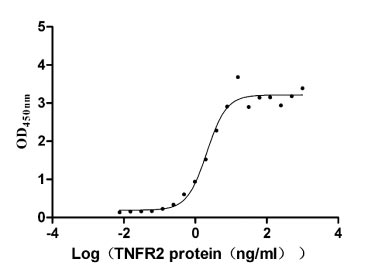Recombinant Human Olfactory receptor 51E2 (OR51E2)
-
货号:CSB-CF861998HU
-
规格:
-
来源:in vitro E.coli expression system
-
其他:
产品详情
-
基因名:OR51E2
-
Uniprot No.:
-
别名:OR51E2; PSGR; Olfactory receptor 51E2; HPRAJ; Olfactory receptor OR11-16; Prostate-specific G-protein coupled receptor
-
种属:Homo sapiens (Human)
-
蛋白长度:full length protein
-
表达区域:1-320
-
氨基酸序列MSSCNFTHATFVLIGIPGLEKAHFWVGFPLLSMYVVAMFGNCIVVFIVRTERSLHAPMYL FLCMLAAIDLALSTSTMPKILALFWFDSREISFEACLTQMFFIHALSAIESTILLAMAFD RYVAICHPLRHAAVLNNTVTAQIGIVAVVRGSLFFFPLPLLIKRLAFCHSNVLSHSYCVH QDVMKLAYADTLPNVVYGLTAILLVMGVDVMFISLSYFLIIRTVLQLPSKSERAKAFGTC VSHIGVVLAFYVPLIGLSVVHRFGNSLHPIVRVVMGDIYLLLPPVINPIIYGAKTKQIRT RVLAMFKISCDKDLQAVGGK
Note: The complete sequence including tag sequence, target protein sequence and linker sequence could be provided upon request. -
蛋白标签:N-terminal 10xHis-tagged
-
产品提供形式:Liquid or Lyophilized powder
Note: We will preferentially ship the format that we have in stock, however, if you have any special requirement for the format, please remark your requirement when placing the order, we will prepare according to your demand. -
缓冲液:Lyophilized from Tris/PBS-based buffer, 6% Trehalose, pH 8.0
-
储存条件:Store at -20°C/-80°C upon receipt, aliquoting is necessary for mutiple use. Avoid repeated freeze-thaw cycles.
-
保质期:The shelf life is related to many factors, storage state, buffer ingredients, storage temperature and the stability of the protein itself.
Generally, the shelf life of liquid form is 6 months at -20°C/-80°C. The shelf life of lyophilized form is 12 months at -20°C/-80°C. -
货期:Basically, we can dispatch the products out in 1-3 working days after receiving your orders. Delivery time may differ from different purchasing way or location, please kindly consult your local distributors for specific delivery time.Note: All of our proteins are default shipped with normal blue ice packs, if you request to ship with dry ice, please communicate with us in advance and extra fees will be charged.
-
注意事项:Repeated freezing and thawing is not recommended. Store working aliquots at 4°C for up to one week.
-
Datasheet & COA:Please contact us to get it.
相关产品
靶点详情
-
功能:Olfactory receptor. Activated by the odorant, beta-ionone, a synthetic terpenoid. The activity of this receptor is propably mediated by G-proteins leading to the elevation of intracellular Ca(2+), cAMP and activation of the protein kinases PKA and MAPK3/MAPK1. Stimulation of OR51E2 by beta-ionone affects melanocyte proliferation, differentiation, and melanogenesis. Activation of OR51E2 by beta-ionone increases proliferation and migration of primary retinal pigment epithelial (RPE) cells. Activated also by the short-chain fatty acids (SCFA) acetate and propionate. In response to SCFA, may positively regulate renin secretion and increase blood pressure. May also be activated by steroid hormones and regulate cell proliferation. Activated by L-lactate in glomus cells.
-
基因功能参考文献:
- Strikingly, OR51E2 was the most highly enriched OR transcript mapped to the human olfactome in lung-resident cells. In a heterologous expression system, OR51E2 trafficked readily to the cell surface and showed ligand selectivity and sensitivity to the short chain fatty acids (SCFAs) acetate and propionate. PMID: 27905542
- OR51E2 is involved in the regulation of cell proliferation and migration in human primary melanoma and melanoma metastasis PMID: 28191688
- Two genes, OR51E2 and SIM2, and two miRNAs, miR-200c and miR-200b, showed significant association with prostate cancer. PMID: 28910345
- Plasma membrane preparations showed that OR51E2 protein is present at the melanocyte cell surface. PMID: 27226631
- PSGR overexpression synergizes with loss of PTEN to accelerate prostate cancer development, and present a novel bigenic mouse model that mimics the human condition PMID: 26028029
- Pyk2-NDRG1 axis is possibly involved in conveying the anti-proliferative effect of beta-ionone in prostate cancer cells. PMID: 25219547
- Increased expression of prostate-specific G-protein-coupled receptor is associated with prostate intraepithelial neoplasia and prostate cancers PMID: 15499628
- two functional promoters regulate the transcriptional expression of PSGR in human prostate tissues, and PSGR is a new target for IL-6 transcriptional regulation PMID: 16149059
- PSGR overexpression is associated with higher percentage of pathologic stage, pT3, and a higher level of preoperative serum PSA in Prostate Cancer PMID: 16231015
- expression of PSGR and PSGR2 relative to AMACR in prostate cancer; AMACR was the most overexpressed, but in some cases expression of AMACR was not significantly elevated while PSGR and/or PSGR2 were substantially elevated PMID: 16491480
- We identified androstenone derivatives as ligands for the recombinant receptor PSGR PMID: 19389702
显示更多
收起更多
-
亚细胞定位:Cell membrane; Multi-pass membrane protein. Early endosome membrane; Multi-pass membrane protein.
-
蛋白家族:G-protein coupled receptor 1 family
-
组织特异性:Highly expressed in the prostate. Also expressed in spleen, liver, olfactory epithelium, retinal pigment epithelium and medulla oblongata. In the retinal pigment epithelium expression is restricted to the pigment cells and choroid (at protein level). Expr
-
数据库链接:
HGNC: 15195
OMIM: 611268
KEGG: hsa:81285
STRING: 9606.ENSP00000380153
UniGene: Hs.501758
Most popular with customers
-
Recombinant Human Lymphotoxin-alpha (LTA) (Active)
Express system: Mammalian cell
Species: Homo sapiens (Human)
-
Recombinant Human HLA class II histocompatibility antigen gamma chain (CD74), partial (Active)
Express system: Mammalian cell
Species: Homo sapiens (Human)
-
Recombinant Human Complement component C1q receptor (CD93), partial (Active)
Express system: Mammalian cell
Species: Homo sapiens (Human)
-
Recombinant Human Carcinoembryonic antigen-related cell adhesion molecule 6 (CEACAM6) (Active)
Express system: Mammalian cell
Species: Homo sapiens (Human)
-
Recombinant Human Myosin regulatory light polypeptide 9 (MYL9) (Active)
Express system: Yeast
Species: Homo sapiens (Human)
-
Recombinant Human Interleukin-2 receptor subunit alpha (IL2RA), partial (Active)
Express system: Mammalian cell
Species: Homo sapiens (Human)



-AC1.jpg)














